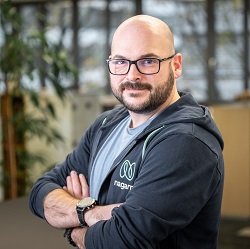In the rapidly changing world of DevOps, organizations are constantly looking for ways to streamline their processes, reduce errors, and improve efficiency. That's where GitOps comes in. It's a new development in DevOps that's quickly gaining traction and promises to revolutionize the way teams manage their infrastructure.
What is GitOps?
GitOps is a methodology that leverages Git, the popular version control system, to manage the entire application delivery process. It involves defining the desired state of your infrastructure in Git, and using automated tools to ensure that the actual state matches the desired state. This eliminates manual processes and reduces errors, resulting in faster delivery.
One of the key benefits of this approach is that you get full visibility and control over your infrastructure. With it, all changes are tracked and auditable, making them easy to roll back too, in case of any issues. This also makes it easier for teams to collaborate and share knowledge, as changes are managed through pull requests, which allows for peer reviews and collaboration.
The opengitops.dev
OpenGitOps is a set of open-source standards, best practices, and community-focused education to help organizations adopt a structured, standardized approach to implementing GitOps.
OpenGitOps declares 4 principles:
1. Declarative
A system managed by GitOps must have its desired state expressed declaratively.
2. Versioned and Immutable
Desired state is stored in a way that enforces immutability, versioning and retains a complete version history.
3. Pulled Automatically
Software agents automatically pull the desired state declarations from the source.
4. Continuously Reconciled
Software agents continuously observe actual system state and attempt to apply the desired state.
To find out more about OpenGitOps, click here .
How GitOps Works
GitOps is based on a simple and straightforward model. You define your desired state of your infrastructure in Git, using a declarative language such as YAML or JSON. This definition is then used to automatically manage your infrastructure, using tools like Kubernetes or Terraform.
The Git repository acts as a single source of truth, and all changes to your infrastructure are made through pull requests. This enables you to track all changes, review them before they are applied, and roll back to a previous version, if necessary.
The automation tools are used to monitor the actual state of your infrastructure and compare it to the desired state defined in Git. If there are any discrepancies, the tools automatically apply the necessary changes to bring your infrastructure into the desired state.
Blog author Thomas Goldberger in our "Let's talk DevOps" - video talk show on the topic of GitOps
GitOps and its tools
When it comes to CI/CD pipelines, GitOps tends to play an interesting role. Since there is no single tool that can do everything required in a CI/CD pipeline (you will need all kinds of package manager, build tools, deployment scripts executed in bash/pwsh/cmd, security tools that analyze source code or dependencies and so on), the idea of GitOps gives you the freedom to choose the best tool for the job - be it open source or closed source tools. It will help you with the most difficult part of a CI/CD pipeline, bringing all the loose parts together and building one cohesive workflow.
Kubernetes is just one example of a cloud-native tool. It is declarative and can be treated as code. When we talk about declarative tools, we talk about tools that work with a “set of facts” instead of a “set of instructions”. For example, “there are four webservers” rather than “start four webservers and monitor their current state”. Using declarative tools enables us to version control the entire set of configurations in Git. By using Git as the source of truth, apps can be deployed, rolled back from (and to) Kubernetes more easily. However, the biggest advantage is that when the black swan event strikes, the infrastructure can be restored dependably and quickly.
IaC in GitOps
Tools that implement Infrastructure as Code (IaC), that provision servers, tools, networks, and other infrastructure have existed for quite some time. These tools come from the need for versioned infrastructure configuration, backups, and the idea of reproducibility - all from source code.
When using declarative tools like Kubernetes as well as an immutable container, it is possible to extend some of the IaC concepts to the application and OS management as well.
Managing and comparing the current state of infrastructure and applications is what encompasses the GitOps philosophy and its best practices. So by adopting GitOps (in combination with Kubernetes), we gain the ability to test, deploy, roll back and roll forward with a complete audit trail. Kubernetes is a big part of all this, because it is almost entirely managed declaratively, and its containers are immutable.
Improved Collaboration and Quality
GitOps enables teams to collaborate more effectively, which results in better quality code, fewer errors, and a more streamlined delivery process. Changes are managed through pull requests, which allows for peer review and collaboration. This results in a more streamlined delivery process, and it's easier to ensure that all changes are in line with your organization's standards and policies.
In addition, the method makes it easier to implement Continuous Integration and Continuous Deployment (CI/CD) pipelines. With its help, you can automate the entire deployment process, all the way from code to production. This expedites delivery and ensures that your infrastructure is always up to date.
Reduced Complexity
One of the biggest challenges in DevOps is about managing the complexity of the infrastructure. With GitOps, you can manage your infrastructure as code (IaC), making it easier to understand, maintain, and configure. It also makes it easier to automate your infrastructure management, as all changes are tracked in Git. This again eliminates manual processes, minimizes errors, and improves the delivery speed.
Increased Visibility and Control
An organization might gain full visibility and control over its infrastructure. All changes are tracked, that enables engineers to roll back easily in case of any issues. Teams will have an easier approach to collaborate and share knowledge, through pull requests. Which enables continuous peer reviews and collaboration.
GitOps also makes it easier to implement security and compliance policies. Engineers can define the policies as code; with the help of automation tools, the policies will be rolled out to the various environments.
Conclusion
With the GitOps methodology, teams can eliminate manual processes, gain the ability to have full visibility and control over their infrastructure, and can collaborate more effectively. This, in turn, reduces the risks of introducing errors, improves the delivery frequency, and enhances the system’s overall quality. With GitOps, teams can focus on delivering value to their customers, instead of simply getting bogged down in manual processes. Try it out today and see the benefits for yourself!
Do you want to transform your DevOps journey? Check this link for more details.





